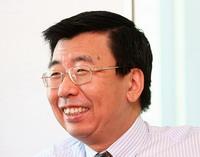French company wants to work on ensuring higher reliability and availability of rail cars
While bidding to supply the world's fastest train to China, Alstom is looking at another gold mine in the country - high-speed train maintenance services.

Kim Chan, China managing director of Alstom's transport sector.
In the eyes of Kim Chan, China managing director of Alstom's transport sector, the logical next step after the country's ambitious goal of building 18,000 km of high-speed passenger rail lines by 2020 is how to ensure greater reliability and availability of the trains that can run at least 250 km per hour."The Chinese operating environment is very challenging because of the distance and the high utilization of the trains. We need to make sure the equipment is operating at an optimal condition and ensure higher reliability and availability. We see a role for us to play because of our experience in Europe," Chan said.
The French company does not only build trains but also provides maintenance services to the West Coast Main Line in the United Kingdom. The West Coast Main Line is the busiest rail artery in Europe and links London and Glasgow.
Alstom plans to cooperate with Chinese local companies to provide maintenance services, Chan said.
"It should be a partnership. We bring our philosophy and our maintenance experience in Europe. But it has to be adapted to the local environment with the help of a Chinese partner. Both sides have roles to play."
China embarked on the world's largest railway network expansion program in late 2008 when the world economic slowdown worsened.

A new high-speed train departs from Wuhan railway station. The train is part of China's new high-speed rail system that connects the cities of Wuhan, Changsha and Guangzhou. [Zhou Guoqiang / Chinafotopress]
As a national priority and a core component of the government's economic stimulus measures, railway investment is expected to peak in the coming two years, with annual investment in between 2010 and 2012 reaching no less than 600 billion yuan ($87.89 billion), according to the Ministry of Railways.
Many new rail lines will be high-speed networks, allowing trains to travel more than 250 km an hour. By 2020, China will own more than half of the world's total length of high-speed rail lines.
Alstom, the world's largest high-speed train maker, has offered the AGV train that can run 360 km per hour as it competes with Bombardier from Canada, Siemens from Germany and domestic suppliers for Chinese contracts.
The AGV, the world's fastest conventional train in terms of designed commercial speed, is expected to enter into commercial service in Italy next year.
But the level of technology transfer has been one of the most important factors that determine to whom the Chinese government awards a rail contract because China has been keen to foster its own rail transport technologies.
"To support the AGV to enter into China, we are flexible with technology transfer," Chan said.
"Given China's ambitious plan to develop its own railway industry and given the size of this market, the government has to do that. For us, technology transfer is a market entry requirement."
Alstom has set up five joint ventures in China since 1986. The joint ventures produce products ranging from railway signaling systems to train traction systems, from motor equipment and components for electric locomotives to hydraulic dampers.
"In fact we are receiving benefit (from the technology transfer). We have a big sourcing program and we leverage on the lower costs in China to support our projects in Europe," Chan said.
But some Western companies are worried that the fast growing Chinese train producers, namely China South Locomotive & Rolling Stock Corp (CSR) and China CNR Corp, will transform into their future rivals in global markets.
"Competition is inevitable. That is life. It pushes everybody to do better," Chan said.
In fact, by leveraging on its industrial base in China, Alstom is currently bidding for a project abroad by partnering with a Chinese company, Chan said, without releasing further details of the project.
"We have a certain advantage to help with each other. It is an issue of how to work with each other and how to maximize the value," Chan said. China's booming urban rail transit sector is another lucrative market for Alstom.
The French train maker has sold more than 1,200 cars to Shanghai Metro Lines and over 400 in Nanjing. It also provides metro signaling systems for Beijing, Guangzhou and Shenzhen. Chan said Alstom was looking for opportunities in China's second-tier cities.
China has launched 31 metro lines in 10 cities. The State Council last year approved another 79 metro lines in 22 cities, which are expected to involve a total investment of 882 billion yuan. That will create huge demand for rail-related businesses.
"Two years ago, we reached an annual production capacity of 2,000 cars. It still lags behind (the booming demand)," Zhao Xiaogang, chairman of China CSR, was quoted as saying by Forbes China magazine.
The Chinese company plans to ramp up production capacity to be able to produce 3,000 metro trains annually this year.






